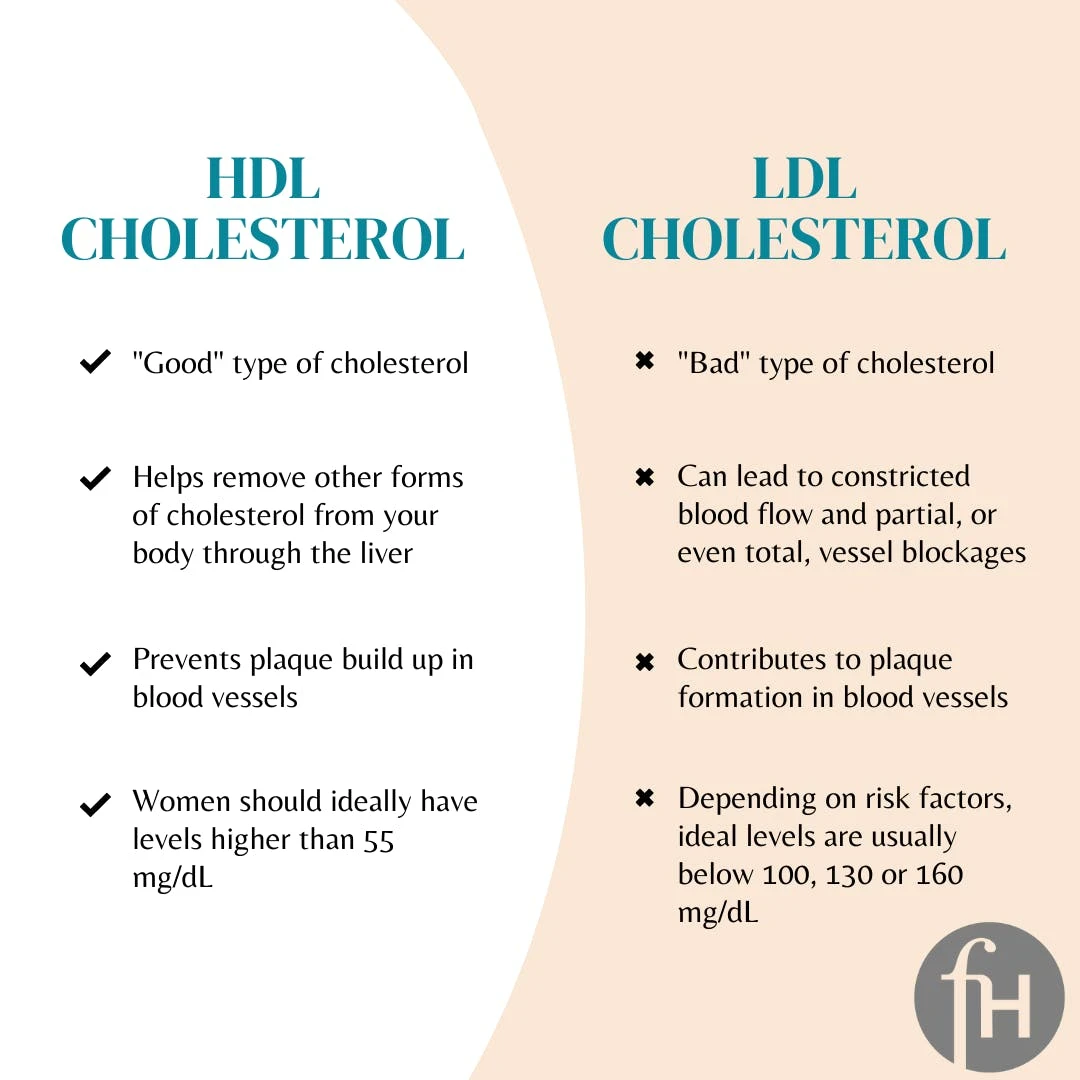What Cholesterol Is Good?
Cholesterol is an important organic molecule that is essential to forming cellular membranes, producing vitamin D and is involved in making some hormones. It is a type of lipid (fat) that travels through the bloodstream, so having high cholesterol can cause blockage of blood vessels and can increase one’s risk of heart disease. There are both harmful and good types of cholesterol and the two main types are high-density lipoprotein (HDL) and low-density lipoprotein (LDL).
What Type of Cholesterol Is Good?
HDL is the “good” type of cholesterol that helps remove other forms of cholesterol from your body through the liver. As a result, HDL can protect arteries and prevent plaque build-up in your blood vessels. This type of cholesterol is known as “good cholesterol” and aiming to have higher levels of HDL in your body is beneficial. Women should ideally have levels higher than 55 mg/dL and men should have levels higher than 45 mg/dL. Avoiding smoking, as well as making sure to exercise regularly and eat soluble fiber and healthy fats such as coconut oil and fatty fish are all ways to elevate your HDL levels.
Which Cholesterol Is Bad?
LDL cholesterol contributes to plaque formation in blood vessels and can lead to constricted blood flow and partial, or even total, vessel blockages. As a result, this can increase your risk for coronary artery disease, heart attack, and stroke. LDL levels should be lower than 130 mg/dL if you do not have diabetes or atherosclerotic disease, and even lower if you have an underlying condition or a predisposition to having high cholesterol, so it is best to check with your doctor to see what levels are advised specifically for you. In some cases, if you have multiple risk factors your doctor may even advise that your levels are below 100 mg/dL.
Cholesterol Daily Intake And Cholesterol Ratio
Cholesterol is only found in animal food sources such as meat, poultry and eggs. Cholesterol intake should not exceed 200 milligrams a day if you are at risk of or predisposed to heart disease. For others without such risks, cholesterol intake should not exceed 300 milligrams a day. If one does have high cholesterol, there are a variety of medications you can take such as statins, fenofibrates and others to lower LDL levels.
A cholesterol ratio can be used as a predictor for heart disease. It is calculated by dividing your total cholesterol number by your HDL cholesterol number. For example, if your total cholesterol number is 250 mg/dL and your HDL is 50 mg/dL, your cholesterol ratio would be 5-to-1. Having a higher ratio is indicative of a higher risk of heart disease. Research states that having a cholesterol ratio of less than 5 and around 3.5 is desirable.
Cholesterol Blood Test
If you are concerned about your cholesterol levels, getting a blood test is a way to determine your amounts of cholesterol. A complete lipid profile will calculate your total blood cholesterol, LDL cholesterol levels, HDL cholesterol levels and triglyceride levels (triglycerides are another form of fat that stores calories). For total blood cholesterol, less than 200 mg/dL is considered ideal. For LDL cholesterol, less than 100 mg/dL is considered normal. For HDL cholesterol, having more than 40 mg/dL is recommended. For triglycerides, less than 150 mg/dL is considered normal.
Related: Is Red Wine Good For You? A Cardiologist Explains The Link Between Red Wine And Heart Disease.
The National Heart, Lung and Blood Institute (NHLBI) recommends getting a cholesterol screening at 9-11 years of age and repeating it every few years. Men ages 45-55 and women ages 55-65 should receive cholesterol screening every 1-2 years. People over the age of 65 should get tested annually. For people who are at higher risk for coronary diseases, have diabetes, are overweight/obese or are undergoing cholesterol-lowering treatment, talk to your physician about getting tested more regularly.
Commonly before a cholesterol blood test, you will be asked to fast for 9-12 hours. Be sure to consult your doctor about the proper pre-testing procedure, as not all levels are affected by fasting.
Can Cholesterol Be Too Low?
Yes, it is possible to have cholesterol that is too low, but it is much less common than high cholesterol. Low cholesterol has been associated with depression, cancer, and anxiety; however, the relationship between these medical conditions and lower cholesterol needs to be further researched.
Why Cholesterol Intake Matters For Women
Cholesterol levels are important for female health as many women are at risk of having high cholesterol, which can directly affect the blood vessels in the heart. This is important to consider as cardiac/heart disease is the leading cause of death in women. A survey found that around 45% of women over the age of 20 have elevated total cholesterol levels of 200 mg/dL or above. However, many women do not know their cholesterol levels.
Importantly, women’s cholesterol levels can fluctuate and are impacted by menopause and age. For example, estrogen (a hormone that promotes HDL levels) is affected during menopause and can cause higher total cholesterol levels and lower HDL (good cholesterol) levels. As a result, it is important to be informed about your cholesterol levels and communicate with your doctor if you have any concerns or questions.
Sources:
- https://www.cdc.gov/cholesterol/checked.htm
- https://www.heart.org/en/health-topics/cholesterol/about-cholesterol/common-misconceptions-about-cholesterol
- https://www.hopkinsmedicine.org/health/wellness-and-prevention/why-cholesterol-matters-for-women
- https://www.mayoclinic.org/diseases-conditions/high-blood-cholesterol/expert-answers/cholesterol-ratio/faq-20058006
- https://www.nhlbi.nih.gov/health-topics/blood-cholesterol
We discuss products we think are useful to people. If you buy something through our links, we may earn a commission. Remember to check with your personal physician to see if a product recommended is right for you.








